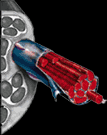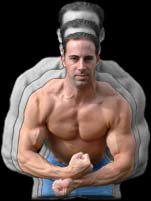Manipulating your hormones will help take advantage and ensure successful adaption, training, health and performance.
All Articles Are Republished With Permission From Intensitymagazine.com
Note: This is part one, click here for part two!
Virtually everything you do in life triggers a hormonal response in the
body. Hormonal levels control our body's actions. It is very important
to understand the key role hormones play in inducing muscular growth as
well as muscular breakdown.

Hormones
are chemical messengers that are secreted by the endocrine system. Once
they are in the blood they travel to specific receptor sites on cells.
Tissue adaptions are partly dependent on hormonal levels. It is
important that the athlete has a basic understanding of these powerful
messengers. Manipulating these hormones to your advantage ensures successful adaption, training, health and performance.
Muscle Fiber Changes
The most important adaption that takes place in muscle tissue is the
increase in contractile proteins, actin and myosin. Other changes occur
such as the synthesis of non-contractile proteins (satellite cells),
which can become part of the contractile element of muscle tissue.
Stimulation of these mechanisms occurs with resistance training.
Decreasing protein breakdown and increasing protein synthesis are the
first steps in hypertrophy.
The anabolic hormones insulin,
insulin like growth factor, testosterone and growth hormone are all
contributing factors to this process. Decreasing the catabolic hormones
such as cortisol is also important in this process. The more muscle
fibers stimulated with a particular exercise, the greater the adaptive
response. Hormones have a great effect on the capabilities and structure
of muscle fibers.
Receptors
The lock-and-key theory states that a specific hormone interacts with a
specific receptor site. The hormone acts like a key while the receptor
site is like a lock. Once the key opens the lock, a message is sent to
the cell to perform a specific action. The genetic material in the
nucleus of the cell either translates the message to mean protein
synthesis or protein breakdown. Once an adaption ceiling is reached, the
cell becomes down regulated (non-responsive) to the hormone. Down
regulation of the receptor inhibits alteration in cell metabolism.
Two Main Hormones
There are two main categories of hormones: steroid and polypeptide
hormones. These hormones affect muscle cells in different ways.
The gonads and the adrenal cortex secrete steroid hormones. The hormone
diffuses across the sarcolemma and binds with its receptor, thus
activating it. When the hormone reaches the cell nucleus it opens up
units that are coded for protein synthesis. The hormone receptor-complex
recognizes certain regulatory mechanisms of genes. The end result is
that messenger RNA is processed and shuttled to the sarcoplasm where it
becomes protein.
Polypeptide hormones are made of amino acids.
Growth hormone and insulin are example of this classification. These
hormones are not fat-soluble therefore they cannot penetrate the
sarcolemma. They rely on secondary messengers to get their message to
the cell nucleus. The change in the receptor as a result of the
interaction with the hormone triggers the secondary messenger. A chain
of intracellular events lead to the physiological response contributed
to the hormone.
Heavy Resistance Exercise
Heavy resistance exercise stimulates significant adaptions in trained
muscles such as increased strength, size and power. Resistance training
causes endocrine glands to secrete hormones. These hormones provide an
excess of information to the body. These hormones elicit different
responses. The pattern and duration of exercise greatly influence the
type of hormone secreted.

This in return greatly effects the tissue adaptions that occur.
Hormonal increases that take place due to resistance training are
different than responses activated by endurance exercise. Motor units
are utilized with resistance training that are not with other types of
exercise. These high threshold motor units are only activated when great
amounts of force are needed, such as with heavy resistance training.
The muscle fibers within these motor units are activated and a great
amount of stress is placed upon the sarcolemmas of the muscle fibers.
The stress elicits changes in sarcolemma permeability to nutrients and
synthesis and sensitivity of receptors are affected. Finally, it is the
force produced in the activated fibers that lead to the anabolic
response in the muscle cells.
During and following exercise, numerous hormonal secretions take place.
The desired outcome is synthesis of actin and myosin and inhibition of
protein breakdown. If the stress is to great or long in duration,
catabolic forces such as cortisol take over the muscle. The hormonal
responses depend on tissues stimulated, duration of exercise and needed
amount of repair.
Once a muscle has reached a high level of development, protein synthesis
is no longer the key mechanism for growth. Thus decreasing protein
breakdown is the number one contributor to muscular growth. Keep in mind
that only the muscle fibers stimulated are subject to affect. This is
why it is important to vary exercises. Only the fibers stimulated
receive hormonal benefits. If you use the same exercise for biceps every
time you train, you will not maximize growth because the same fibers
are stimulated continuously. Angles and loading parameters control the
extent of hormonal interaction within muscles.
The response of muscles to hormones is dependent on a few factors. If
there are great amounts of the hormone in the blood, the chances of
affecting the receptors are greater. If the cell is close to its genetic
ceiling, the receptor becomes less responsive to the hormone. With
heavy resistance training the recovery ability correlates with muscle
fiber size. Incorrect training protocols can result in the downside of
hormones, catabolism. Interactions between hormones and muscles can
negatively influence cellular structure or have a positive effect on
growth.
There is an array of factors that contribute to hypertrophy. However,
increased force production cannot be contributed to hypertrophy alone.
Neural factors play a great role in maximum force production. Each
individual varies in forms of neurological efficiency just as they do
with hormonal levels.
Hormones In Blood
Blood levels are sometimes used to test for the secretion of hormones.
This can be a complex task because the hormonal levels are ever changing
in the bloodstream. It should be noted that just because a hormone is
present in the bloodstream does not mean that it will successfully reach
the receptor site. Although, the higher concentrations of the hormones
in the blood the greater possibility for the hormone to bind to the
receptor.
The ideal situation for anabolism is to have a higher number of anabolic
hormones in the blood than catabolic hormones. This usually leads to
positive cellular adaptions.
This concludes Part One of the two part series on manipulating your hormones. In part two, we will explore the specific actions of the primary anabolic and catabolic hormones.
Note: This is part one, click here for part two!
In part one,
we discussed the basic relation between hormones and cellular
adaptions. In part two, we will discuss specific hormones and their
effects on the body.
The anabolic hormones we will be discussing are testosterone, growth hormone, insulin and insulin like growth factors. These are the primary hormones involved with muscular growth.
Testosterone
Everyone involved with the exercise industry has some conception of
testosterone. To most it is an evil word, "TESTOSTERONE." This stuff
makes people commit violent crimes, die of heart attacks and suffer from
strokes. It also allows anyone to put on extraordinary amounts of
muscle. Where do these ideas come from? They come from ignorant people
who know zero about this hormone.
Testosterone indirectly effects protein synthesis by releasing growth
hormone, which increases the release of Insulin Growth Factor (IGF) from
the liver. Testosterone has effects on the nervous system, which lead
to increasing neurotransmitters and increasing neuromuscular junctions,
which enhance muscle size. As neurological efficiency increases, force
production also increases.
The mechanism in which testosterone interacts with the cell nucleus is
inexact. Once testosterone is secreted, a transport protein called
globulin to a receptor site carries it. From here, a message is
activated and sent to the cell nucleus. Protein synthesis is the result
of this series of events.
Concentrations of testosterone are often used as an anabolic marker.
There are certain exercise variables that can have a positive effect on
blood testosterone levels.
They Are As Follows:
- Workouts lasting under sixty minutes.
- Multiple sets
- Compound exercises
- Short rest intervals (one minute)
- Heavy resistance, 80% - 90% of 1RM.
Have you ever heard the saying, "Squat and deadlift and your whole body
will grow." Elevating testosterone levels as well as stimulating large
amounts of muscle mass are the reason this occurs. If you rely solely on
the use of machines, try introducing compound exercises and expect your
gains to accelerate.

The majority of research done on hormonal responses in relation to
exercise has been tested on male subjects. Testosterone responses have
been credited as the major determinant in the difference between male
and female muscularity and force production. On average, males produce
about ten times the testosterone of females. Thus far, studies do not
show any significant changes in women's testosterone levels due to
exercise.
Growth Hormone
Growth hormone has been cited as a growth mechanism in skeletal muscle
tissue and other tissues in the body. Growth hormone is important in the
normal growth of a child as well as the role it plays in adapting to
exercise.
Some Of The Roles Of Growth Hormone Include:
- Increased protein synthesis
- Utilization of fatty acids
- Increasing amino acid transportation
- Increasing cartilage growth
- Promotes lipolysis
- Reduces carbohydrate utilization for energy
Most studies say growth hormone is released due to neurological signals
from the nervous system stimulated by exercise stress and anxiety.
Signals to the hypothalamus cause a hormonal release that stimulates the
secretion of growth hormone. Growth hormone also stimulates the release
of IGFs from the liver. IGFs are potent anabolic agents, which enhance
protein synthesis.
Blood levels of growth hormone vary throughout the day. The highest
levels of secretion occur during sleep. This is one of the reasons
adequate sleep assists the body in recovering and growing properly.
Exercise has been shown to increase growth hormone secretion at any time
during the day.
The pharmacological use of growth hormone is a highly debated subject.
Some experts say growth hormone treatment is the main reason
bodybuilders are much more muscular and ripped than they were in the
past. Others report growth hormone is only beneficial to bodybuilders
that simultaneously use anabolic steroids. Debating this topic is
another article in itself. In this article the main concern is
increasing endogenous mechanisms that result in growth hormone
secretion. Further research is needed to tell us just how exogenous
growth hormone compares to natural growth hormone production.
Increased hydrogen ions appear to stimulate the release of growth
hormone. This means higher blood lactate concentrations (closely
associated with hydrogen ions) mean higher blood levels of growth
hormone.
Light resistance exercise has been shown to be non-effective in raising
growth hormone levels. Kraemer found when using moderate resistance
(10RM) with multiple sets and short rest periods (1 minute), serum
growth hormone levels increased. By carefully designing your
resistance-training program it is possible to reap the rewards of
elevated growth hormone.
When going through the menstrual cycle, women have higher blood levels
of growth hormone than men. Research on females has shown when using
heavy resistance (5RM) and resting for three minutes between sets, no
significant rise in growth hormone occurs. However, when using moderate
resistance (10RM) with short rest periods (1 minute) rises occur.
Varying routines is important for altering levels of growth hormone.
Insulin
Insulin is a peptide hormone that is secreted from the beta cells of the
pancreas. Insulin can have positive effects on skeletal muscle, but it
can also enhance bodyfat levels.
Insulin Functions Are As Follows:
- Lowers blood glucose.
- Promotes cellular uptake of carbohydrates, amino acids and fatty acids.
- Excessive insulin results in fat storage.
insulin drop during exercise is reduced by the training effect. Further
research needs to be conducted to determine insulin's response in
regards to training.
"Injectable insulin is very dangerous and can result in fatality within a matter of minutes."
Insulin acts as a powerful anabolic agent by shuttling amino acids into the muscle cell. Many experts view this hormone as the most powerful
anabolic agent in existence. This is why the use of injectable insulin
has become commonplace among bodybuilders. Injectable insulin is very
dangerous and can result in fatality within a matter of minutes. If you
use injectable insulin be sure it is under the supervision of a doctor.

Manipulating insulin levels is important for physique purposes. The
right amounts at the right time result in muscular gains while
chronically high levels result in fat storage. Excessive levels of
insulin reduce testosterone and growth hormone levels. High levels of
insulin can also stop the production of eicosanoids. Jay Robb has stated
that production of eicosanoids is synthesized within the body from
essential fatty acids especially from linolenic acid. Levels of insulin
can be manipulated by carbohydrate intake. Too much of a good thing can
result in a bad thing.
IGF
Insulin like growth factors (IGFs) are secreted by the liver after
growth hormone signals liver DNA to synthesize them. IGFs are classified
as IGF-I, a 70 amino-acid polypeptide, or IGF-II, a 67 amino-acid
polypeptide. IGFs travel in the blood while being attached to binding
proteins where they attach to receptor sites.
The disruption of various cells including fat and muscle cells
stimulates the release of IGF. Fat cells store high levels of IGF, while
skeletal muscle contains small amounts. It is likely that non-liver
cells release IGF without the assistance of growth hormone. It is also
possible that specific cells produce IGF, but do not release it into the
bloodstream.
Binding proteins play an important part in the function of IGF. IGF has
been shown to stimulate the release of binding protein within the muscle
itself, therefore changing the cells responsiveness to IGF. Nutritional
profile has also shown to be an important factor in IGF responsiveness.
Sudden changes in nitrogen balance and protein intake seem to effect
IGF levels. Binding proteins act as a reservoir for IGF. These proteins
release IGF once a receptor site is open. Thus the amount of IGF
degradation is reduced.
At this time, it is unclear how heavy resistance training effects IGF
levels. One study showed that a variety of different exercise patterns
elicited an IGF rise about two hours after training. Further research
needs to be conducted to learn more about exercise effects on IGF
levels.
Controlling anabolic hormones is one of the most important aspects of
controlling your physique. These powerful hormones previously discussed
can help you to reach your fullest potential.
Main Catabolic Hormone
The most powerful catabolic hormone is cortisol. Minimizing cortisol
levels can assist greatly in maximizing your growth potential.
Cortisol is a hormone that is produced by the adrenal cortex. This
hormone is released to help the body deal with stress and provide energy
to the body. The problem with this hormone is the catabolic effects it
has on the body.
These Effects Are As Follows:
- Increases proteolytic enzymes (enzymes that degrade protein)
- Turns amino acids to carbohydrates
- Inhibits protein synthesis
- Breakdown of collagen and ligament tissue
- Cortisol has greater catabolic effects in fast twitch fibers in comparison to slow twitch fibers
and causes a loss of contractile protein. This loss results in muscle
atrophy. Inside the muscle, anabolic hormones such as insulin and
testosterone counter the actions of cortisol. If the anabolic hormones
occupy a greater number of receptors, protein is maintained or enhanced.
When cortisol is bound to a greater number of receptors, protein
breakdown is enhanced. Ensuring that anabolic hormones are higher than
catabolic hormones is important for muscle maintenance and growth.
Resistance training that utilizes high volume; large muscle groups and
shorter rest periods are responsible for the highest levels of cortisol.
This is interesting because the stimulus that causes the greatest
catabolic effect also causes the greatest growth hormone response. While
cortisol levels promote breakdown, short time increases could also help
with muscular growth. Muscles must be broken down in order to repair
themselves and grow. Short-term cortisol elevation would help this
process.
Athletes often use testosterone-cortisol ratio blood levels to determine
if their bodies are in a growth state. This sounds logical, but this
ratio has proven unsuccessful as being a marker for mass and strength
gains. The multiple roles of cortisol make the test inadequate in being a
true marker of anabolism or catabolism.
In conclusion, it is evident that hormones are responsive to muscle
tissue. Performance will be enhanced maximally by proper use of anabolic
hormones.
References
1. Baechle, T.R. (1994) Essentials of Strength Training and Conditioning. Human Kinetics.
2. Dipasquale, M. (1995) The Anabolic Diet. Optimum Training Systems.
3. Hale, J. (2000) Optimum Physique. Jamie Hale.
4. Hatfield, F.C. (1993) Fitness The Complete Guide. The International Sports Sciences Publishing.
5. Robb, J. (1994) The Fat Burning Diet. Loving Health Publications.
Note: This is part two, click here for part one!
